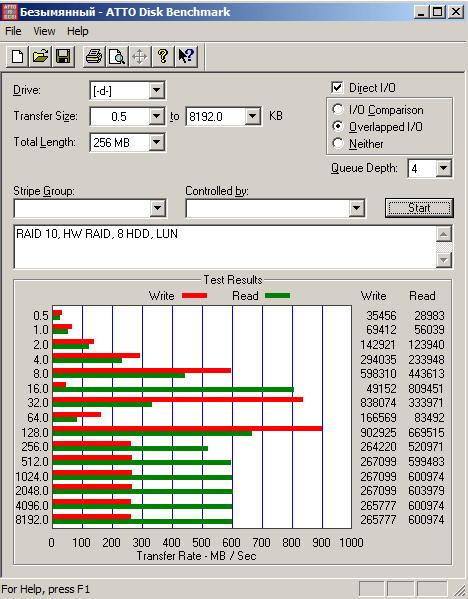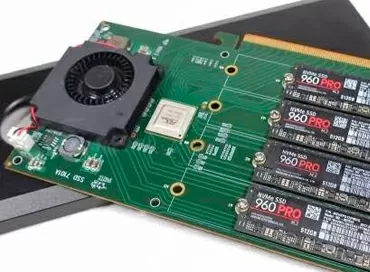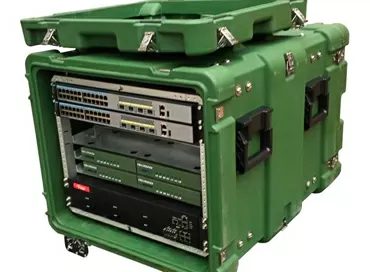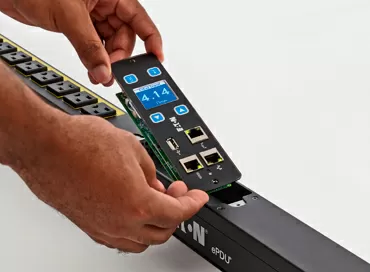Review of SRV-Legion SL2500 server of floor-standing type for small organizations.
Floor-standing servers are in steady demand in the small and medium-sized business sector, among those organizations where there is no IT infrastructure, in principle, it is impractical to install a rack for equipment, and the server is bought mainly for accounting , and most often stands in the same place. Therefore, such machines should work quietly, provide a large disk space for the company's shared resources, and in the wake of the general adoption of virtualization, be also efficient enough to run several virtual machines. SRV-LEGION SL2500 series servers on Supermicro platforms are designed to meet all these requirements.
Up to two Intel Xeon E5 26xx v2 processors can be installed in the SL2500/4UT8LG2 server. The server is designed with a low noise emission - up to 28 dB, which is even quieter than many desktop computers. The server is assembled in a full tower format, and is designed for most typical tasks. Supports up to 512 GB of RAM (8 slots), 3 full PCI Express 8x expansion cards, 1 PCI Express 4x, 1 PCI Express 1x, and 1 full PCI 32 slot for any older expansion cards. For remote monitoring, the software IP-KVM built into the server is supported. Disk space can be recruited by eight hot-swappable SAS or SATA HDDs.
According to its characteristics, this is a mid-range server, for example, 8 memory slots, although they support up to 512 GB of memory, but with prices for DIMMs with a volume of more than 16 GB, we can say that configurations will be really in demand 64GB or less. The built-in Intel SW RAID controller with support for levels 0.1 and 10 can fully meet the needs of small databases on 4-disk configurations. For more disks and creating two or more disk groups, it is better to use a discrete RAID controller. As such a solution, in the SRV-LEGION configurator you can choose any of 21 models of HBAs and SAS/SATA RAID controllers up to 8 ports from LSI Logic and Adaptec.
This server has only 2 gigabit network ports, which may be enough to act as an access server or a database, but of course, it is not enough to distribute virtual machines across subnets. In any case, 5 expansion slots with PCI Express interfaces will allow you to install both a RAID controller and a network card with 4 ports, and even there will be room on the FC controller for connecting to the storage system. When configuring the server, you can choose from 12 Intel, Qlogic and Mellanox network and FC controllers.
SRV-LEGION SL2500/4UT8LG2 server uses 1 power supply unit 865 W with power factor compensation. As is usually the case, the power reserve is huge here. Now it's time to look at the design features of the SRV-LEGION SL2500/4UT8LG2.
Construction SRV-Trade SL2500/4UT8LG2
Outwardly, the server does not stand out from the models of its class. Unless, on its cover there is a sticker with service information about the model, such as the serial number, exact model and specification of the technical specification. However, it should be borne in mind that when mounting in a rack, the top plastic cover is removed, and the sysadmin will have to think about where to store the cover with the serial number glued to it.

The server indication is moved to the very top, above the 5-inch compartment. There are also two USB ports, and there is even a Reset button, such a rarity on modern servers. SRV-LEGION SL2500/4UT8LG2 has 3 compartments for 5.25 "devices, one of which is combined with a 3.5" one. Traditionally, the SRV-LEGION SL2500/4UT8LG2 can be installed with a DVD drive, and if you are not sorry for $ 30, you can do it.
 .
.
You can install up to 8 hot-swappable hard drives in the server. The HDD compartment is locked with a key, and each of the hard drives is installed in a metal slide with a convenient locking mechanism, which has not been changed by the case designer for many years. That's right - in terms of convenience, they are not inferior to solutions used in servers of other brands.
 .
.
In floor-standing servers, there is no desire to save space as much as possible, so you can use as many ports as the user needs. Here you are offered 6 (2 on the front panel) USB 2.0 ports, and 2 Gigabit LAN, and a dedicated RJ45 for control and console access to the server, and RS232 with VGA. You can implement 4 more USB ports by connecting brackets with ports. All USB ports are 2.0.


The side cover cannot be locked, which can be considered a drawback, because unauthorized people, including cleaners or other service personnel, often have access to the server. Additional security would be welcome and you have to rely only on the chassis intrusion sensor.
The build quality of SRV-LEGION SL2500/4UT8LG2, to be honest, is surprising. Rarely do you see such attention to detail in a desktop server format: all cables are routed as compactly as possible in the case, tied together and packed tightly to avoid airflow resistance.

When assembling the server, the left cooler fan was rotated 180 degrees so that both coolers work in the same direction as the entire server cooling system.

And the cooling system of the components is controlled by two hot-swappable system fans located immediately after the hard drive bay. Another system fan, installed on the rear wall, not only does not have a hot-swap function, but for some reason is very difficult to remove. If you plan to fully charge the SL2500/4UT8LG2, you can install 2 more system fans inside the case. By the way, fans from Sanyo Denki are used here.

The motherboard has 10 SATA ports, 2 of which are SATA III compliant. In case you want to use DOM (Disk-On-Module) disks. In general, the SRV-LEGION SL2500/4UT8LG2 server structurally allows the customer a lot. Even in comparison with many rack systems, it has a number of advantages, and above all, in the expansion options: as many as 6 full-size slots for expansion cards, as many as 8 disks, plus the ability to use DOM modules, and an internal USB port from which you can load the operating system .

And, of course, two powerful Intel Xeon E5-2620 v2 processors with a thermal package of up to 80 W each - this is good computing power.
Remote control and monitoring
BIOS of the SRV-LEGION SL2500/4UT8LG2 server corresponds to what we expect: settings for machine health monitoring systems, parameters of the RAID controller integrated into the motherboard (one of two emulation modes: Intel for Windows and Adaptec for Linux ), network boot, various power saving options, etc.

All modern Supermicro server platforms, one of which is used in the SRV-LEGION SL2500/4UT8LG2, support network remote management (IPMI). Some basic parameters can be monitored when connecting the Out-of-Band type via the first network port.
Through the virtual console, you can not only configure the BIOS parameters of the motherboard and expansion cards, but also install operating systems from the connected virtual media in the form of images. So sysadmins can perform complete remote control of the server, including power supply.
IPMI management systems operate independently of the server itself, which allows you to overload the machine even when the server is frozen, turn it on when it is turned off, and receive information from all sensors of the machine. Previously, we thought that virtual KVM was inferior in speed and convenience to real IP-KVM, but in the new generations of Supermicro motherboards, the remote control function is so well-tuned that it can be compared to an RDP connection in terms of usability. Of course, there are still lags in the response of the cursor to mouse movements, but here they are minimal. And today we can already say with confidence - if you buy a server like SRV-LEGION SL2500/4UT8LG2, you don't have to think about buying IP-KVM.
Even such a simple function as recording the server boot sequence and POST codes, which is present in the IPMI system, is invaluable in case you need to find out what error the server gives during the boot process, and the slow initialization of the video card (like and in most servers) does not allow you to see it on the monitor.
During installation, practically no system settings are required - everything works, as they say, right away. Unless you need to connect a network cable to the server before turning on the power.
If you order a discrete RAID controller based on an LSI processor, you will get convenient remote management with the ability to create and delete arrays, change parameters of existing arrays, and create and delete LUNs. The LSI 9271-8i installed in our server allows you to create several virtual disks within one RAID array.
Testing
The first thing we pay attention to when turning on the server is its noise level. In fact, the manufacturer met our expectations: even in a dual-processor configuration with eight hard drives, the machine is so quiet that you can put it next to your desktop. There is a slight hum from the power supply fan, but you only pay attention to it in complete silence. To check how this quietness of work will be maintained in different modes, we `` warmed up '' server with utilities for maximum computer load used when testing coolers.
An hour of server operation with the maximum load of two processors and disk subsystem did not change the situation - the SL2500 server slightly raised the fan speed, but remained almost inaudible. Perhaps we can assume that in this parameter the test was passed with an A. If you want a server that will stand in the same space with the staff, which will work silently - please, SRV-LEGION SL2500/4UT8LG2 is suitable for this task.
Server config:
- 2 x Xeon E5-2620
- 32 GB RAM
- 8 x Hitachi HUA72201 1 Tb RAID 10
- LSI 9271-8i/w BBU
- Windows Server 2008R2
First of all, let's take a look at the speed of the built-in RAID array using a utility from ATTO.

The cached write speed reaches 600 MB/s and the read speed is 265 MB/s. Very good performance for working with large amounts of data.

Basically, if you need a powerful disk subsystem for your database, then using SAS disks and a discrete RAID controller, you can fully meet the requirements for disk system speed. The performance is sufficient for 1C, MySQL and file storage.
|
Fritz CPU Benchmark Results | |
| Relative Speed | 30.76 |
| Kilonodes p/s | 14764 |
Processor performance can be assessed using Fritz CPU Benchmark. The performance of the SL2500/4UT8LG2 processors will be sufficient for mathematical calculations, including model calculations and simulation, if your organization uses such applications.
Conclusions
We are already used to the fact that with each new generation of system logic the servers are getting faster, and we do not pay much attention, realizing that for most tasks of an average company, some 2-processor configuration will be enough with fast hard drives. '' The SRV-LEGION SL2500/4UT8LG2 server demonstrates that all the requirements of a small organization to the computing heart of an office can be packed into a tower and housed in the HR department. Fast RAID controllers and 8 disks with a speed of 7200 RPM will give you up to 600 MB/s for writing and up to 1000 MB/s for sequential reads in RAID 10. For 1C, this is a headroom for many years to come. Two Xeon E5-2620 v2 processors will allow you to install multiple virtual machines, moving the entire infrastructure to one server. Even so, you do not need to equip a server rack, equip air conditioning for equipment and spend money on rack solutions - we simulated such a load on the SL2500/4UT8LG2, which is impossible to achieve in real conditions, and it continued to work almost silently.
There will also be no problems with the warranty service of the machine: standard for the industry 3 years warranty, operational support in 71 regions of the country - everything is like more expensive branded devices, only in this case you are dealing with a domestic product production, with more affordable components for further expansion.
Mikhail Degtyarev (aka LIKE OFF)
01/12.2013


















